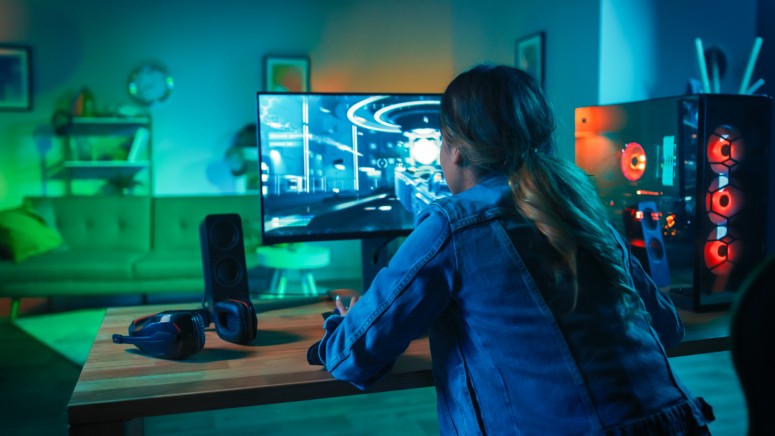
10 Best FreeSync Gaming Monitors in 2020
After Nvidia unveiled G-Sync, AMD came up with a similar technology of their own called FreeSync. Much like Nvidia’s product, FreeSync is an adaptive refresh rate technology that enables your monitor to synchronize its refresh rate with your in-game frame rate. This makes animation appear smoother on high refresh rate displays, even when your PC is not able to push high frame rates.
Unlike G-Sync, however, FreeSync is not proprietary. Manufacturers usually have an easier time implementing this feature into monitors, mainly because the software is open source and does not require any royalties. Granted, it is perhaps not as polished as G-Sync most of the time, due to the fact that AMD doesn't really bother testing the monitors in their labs like Nvidia does with G-Sync monitors.
The good news is that FreeSync monitors can sometimes be G-Sync-compatible as well. That is not always the case, but there are plenty of models out there that can also be used with G-Sync even if Nvidia does not officially grant them the “approved” sticker. Because of this, FreeSync can be used with both Nvidia and AMD cards, which is obviously not the case with G-Sync monitors.
Lastly, it goes without saying that FreeSync does not really make sense on monitors that only support up to 60Hz. You get the most value out of the technology when used in combination with a high refresh rate display. Thus, it’s important to aim for something with at least 100-120Hz at the very least.
What to Look For in a Good FreeSync Monitor
Just like with any other gaming peripheral, there are several things you must consider before making a purchase. It’s not necessary to tick all of these boxes in order to be content with your choice, but it’s important to at least know what you are interested in beforehand. As such, here are some of the things that should be taken into consideration before buying a FreeSync monitor:
- Resolution. This is by far the most important feature when it comes to gaming monitors, because it affects the performance of your video games. A higher resolution makes it significantly harder to achieve consistent frame rates in modern games, which means that you will also need a beefier PC. On the other hand, higher resolutions also look better in terms of sharpness, so that may be more important to some of you. Competitive gamers for example do not care about such things, which is why a higher refresh rate is always more important to them.
- Aspect ratio. We have already covered the pros and cons of ultrawide monitors a while back, but it’s worth mentioning this aspect again. FreeSync displays come in a variety of form factors, so you are definitely not stuck with 16:9. It really depends on the types of games you like to play, however, since the ultrawide aspect ratio may actually be a significant drawback in certain cases.
- Panel type. There are three main types of panel technologies on the market right now, each one of which has its benefits and drawbacks. You can choose between VA, IPS, and TN panels in most cases, although we have yet to see any TN ultrawides. In short, the panel technology affects color accuracy, contrast levels, brightness, and viewing angles, which means that you need to carefully consider each point and think about how it would affect your day-to-day activities.
- Refresh rate. Without a doubt, having a high refresh rate monitor is a must in 2020, especially since the technology has gotten a lot cheaper in recent years. 60Hz is just not enough to really feel immersed into your games, so we would definitely recommend something with at least 120Hz if possible. This also ties in with the fact that FreeSync is practically wasted on a 60Hz panel anyway.
- Response time. Although many people choose to ignore input lag when shopping for a monitor, it can actually be an extremely annoying factor while gaming. Many budget monitors skimp out on this, choosing to boast high refresh rates instead. The bad news is that a high response time is that much more noticeable on a high refresh rate monitor, given the fact that it takes longer for the pixels to turn on and off. Something lower than 8ms is preferable, although 1ms should be the goal for any hardcore gamer.
- Input options. While it is true that DisplayPort has been the de facto standard in the world of gaming monitors lately, it’s still a good idea to have a back-up HDMI port in there as well. This is especially important if you want to use the monitor with a laptop, since HDMI is your only option in that case. Furthermore, a decent display should also come with a few USB ports and an audio jack.
- Build quality and a sturdy stand. This is another thing that many people forget to think about before purchasing a monitor, and it can lead to some pretty annoying problems. Even if the display is built entirely out of cheap plastic, it should at least be sturdy enough not to break at the lightest touch. In addition, an adjustable stand can really make a difference when you are trying to get the best viewing angle.
10 Best FreeSync Gaming Monitors in 2020
Now that you know what to look for in your next FreeSync monitor, it's time to unveil our picks for the best FreeSync gaming Monitors in 2020.
1. Best All-Rounder FreeSync Monitor - Samsung CRG9 49”
Playing games in a 32:9 aspect ratio can be an incredible experience if the stars align, especially if your monitor features a resolution that makes up for the extra horizontal space. At 49 inches, the Samsung CRG9 offers the best of both worlds, at least if your graphics card can handle the huge number of pixels.
At 5120 by 1440, the display is just below 4K in terms of pixel count, which means that your PC may struggle with modern triple-A games. On the other hand, you also get 120Hz in terms of refresh rate, so it’s a good long-term investment if you are planning to keep the monitor for a couple of years.
Samsung also included full HDR support and 1000 nits of peak brightness, which is pretty much top-of-the-line as far as HDR goes. Obviously, this feature also comes with 10-bit color support since it is required in order to experience true high dynamic range when it comes to colors as well.
The VA panel has only 4ms of input lag according to Samsung, so you do not have to worry about motion blur or various other artifacts that might ruin your immersion. Speaking of which, VA also means that you get very deep blacks and unmatched contrast. The colors are not as bright as they would be on an IPS panel, but that’s a minor inconvenience when you consider the rest of the benefits.
Lastly, the included stand is very adjustable and robust - as it should be when you consider the price. The only downside is that the stand may occupy a fair portion of your desk, so make sure you know exactly how much space you can spare before pulling the trigger on this monitor.
Pros:
- The ultimate ultrawide gaming experience
- 120Hz refresh rate at 5120 x 1440 is nothing to sneeze at
- Can also be great for productivity, thanks to the ample amount of screen real estate
- 4ms input lag
- Great contrast thanks to the VA panel
- Supports HDR and can output 1000 nits at peak brightness
Cons
- Expensive
- Can be a bit too big for a regular desk
2. Best High Refresh Rate FreeSync Monitor - MSI OPTIXG27C4 27″
If high refresh rate is what you are looking for in a monitor, then the OPTIXG27C4 is definitely a good choice. 165Hz is extremely good when used in combination with FreeSync, especially since this is a 1080p panel. The low resolution should allow you to get very high frame rates in almost any game, even if your hardware is not exactly top-notch.
In terms of response time, the panel has a 1ms GtG input lag, which makes it practically impossible to notice any kind of motion blur or screen tearing. This is especially impressive when you consider the fact that the monitor uses a VA panel, which is not usually as fast as TN or IPS.
The bad part is that the colors won’t be quite as vibrant as on an IPS panel. Since this is a gaming monitor, however, this should not matter too much. Naturally, you should probably stay away from VA panels if you are also planning on doing some photography work or any kind of graphic design. There is also no HDR either.
It’s worth pointing out that you can only get 165Hz if you are using the monitor through DisplayPort, since the HDMI input can only handle 144Hz. With that being said, 144Hz is actually very respectable, so it’s not a dealbreaker if your GPU does not have a DP output. A decent HDMI cable is also recommended, since cheaper ones may not be able to handle the throughput.
Pros:
- Very high refresh rate
- 1ms input lag
- Curved panel
- Decent size for a 1080p display
- Comes with an USB hub
Cons:
- A bit expensive
- Not a lot of adjustability in the stand
3. Best 4K FreeSync Monitor - Asus ROG Strix XG438Q 43”
In case you are in the market for a multi-purpose gaming monitor, the Big Format Gaming Display from Asus can be the perfect choice under the right circumstances. The 43” of screen real estate make it perfect for couch gaming sessions, but it is also small enough to fit on a bigger desk if that’s your jam.
The monitor also supports up to 120Hz at 4K, which is not easy to come by - especially in this price bracket. It’s also hard to imagine that you will be able to hit the frame rate limit at 2160p in most games, which means that the FreeSync support is actually a necessity. On the other hand, variable refresh rate is not a major concern for console gamers, so that may not even matter to some of you.
Related: The Best 4K Gaming Monitors
Since this is basically a TV in disguise, it’s really no surprise that you also get two 10W speakers built into the monitor, as well as a handy remote. Obviously, the remote is used to control the OSD and the sound volume, but it’s still going to be extremely useful when you are sitting on the couch and you don’t want to move in order to fiddle with the settings.
Lastly, you would think that such a big display also comes with quite a few additional ports since there’s so much room for them. That’s not the case, since you only get a DisplayPort, 2 HDMI ports, and two USB ports. While it makes sense for the audio jack to be missing, it’s a bit annoying to see only two USB ports.
Pros:
- Great choice for both PC and console gamers
- DisplayHDR 600 certification
- Goes all the way up to 120Hz at 4K
- Comes with built-in speakers and a remote
- Sturdy metal stand
Cons:
- BFGDs are not everyone’s cup of tea
- Rather few USB ports
4. Best 1440p FreeSync Monitor - Samsung C32HG70QQ 32”
High refresh rate 1440p displays are not a novelty anymore, especially since PC hardware has gotten powerful enough in recent years to handle them with ease. As such, the Samsung C32HG70QQ is capable of up to 144Hz at its native resolution, which means that you can really push your computer to its limits without being held back by your monitor.
The curved VA panel is also built using Samsung’s QLED technology, which makes the colors pop a bit more than what you can expect from conventional VA monitors. In addition, the response time is only 1ms, and that’s pretty low for this type of panel. In fact, 1ms is about as low as you can get nowaday, barring the occasional prototype.
In terms of extra features, the monitor comes with HDR support and a peak brightness of 600 nits, which qualifies it for a DisplayHDR 600 certification. You also get 1.07 billion colors instead of 16 million thanks to the included 10-bit color support. This definitely helps a bit in regards to HDR content, but you probably won’t be noticeable outside of that.
You also get 1 DisplayPort and 2 HDMI ports, as well as a USB hub for your peripherals. As far as the stand is concerned, the design is a bit weird and clunky, but it does its job in terms of adjustability. You might need a bit of extra space on your desk to accommodate the stand, however.
Pros:
- High refresh rate for a 1440p monitor
- 1ms response time
- 2 HDMI ports and a USB hub
- Curved panel
- Highly-adjustable stand
- HDR support with 600 nits of peak brightness and 10-bit color
Cons:
- The stand design is a bit weird
5. Best Ultrawide FreeSync Monitor - MSI Optix MAG341CQ 34”
While technically our #1 pick is also the best ultrawide FreeSync monitor, not everyone has the money to buy a 49” monitor. The MSI Optix MAG341CQ is a very strong alternative for medium-range budgets, and you don’t lose too much in terms of performance. However, there are some minor annoyances you will have to live with.
Related: The Best Ultrawide Gaming Monitors
To begin with, the display’s resolution is 3440 by 1440, which is the sweet spot as far as ultrawide panels go. Furthermore, the monitor can also handle up to 100Hz at this resolution, which is very respectable at this price point. Naturally, the FreeSync support makes it easier to handle lower frame rates as well, so you should have a very smooth gaming experience even when your PC is struggling a bit.
The first downside comes in the form of a relatively high response time. 8ms is not horrible, but it’s definitely higher than most other monitors on this list. On the other hand, this will only be noticeable if you like to play competitive games, which is not actually a good idea on an ultrawide anyway. As far as casual gaming is concerned, 8ms should be enough.
The other downside is that you are not getting the royal treatment in terms of stand adjustability. The included stand is pretty much a one-trick pony, so you may have to invest in a third-party monitor arm if you want to unlock this perk as well. There is also no HDR or 10-bit color support, although that should be expected in this price bracket.
Pros:
- Supports up to 100Hz at 3440 by 1440
- The VA panel offers great contrast and deep blacks
- Good color accuracy
- The curved design helps with immersion
- Fairly inexpensive, considering the specs
Cons:
- Basic stand with little-to-no adjustability
- No HDR
- 8ms response time
6. Best 1080p FreeSync Monitor - ViewSonic XG2402 24”
The ViewSonic XG2402 has a lot of things going for it in terms of pure specs - and that’s on top of the fact that it’s also quite affordable. As such, it supports up to 144Hz at 1080p, which makes it a good choice if you are trying to get the most out of your hardware. This shouldn’t be hard to do at 1080p, so it’s actually a better way to experience high refresh rates.
The panel itself relies on TN technology, which is why the input lag is only 1ms as well. This makes motion blur a non-issue even at high frame rates, and it’s also why professional gamers should give this monitor a chance as well. On the other hand, TN panels also suffer from contrast and brightness issues, so you may want to look for something else if color accuracy is a priority.
It’s also worth noting that you do not get HDR or 10-bit color support. No one really expects these features on 1080p displays, however, so it shouldn’t be a big deal for most people. In fact, HDR does not make sense on a TN panel anyway, given the fact that they are not bright enough to handle the dynamic range required for such purposes.
The other good news is that both the DisplayPort and the HDMI ports can handle 144Hz, which is great news if your GPU is a bit older. This also means that you can hook up your laptop to this monitor without taking a performance hit in the process.
The included stand is very sturdy and adjustable as well, not to mention the fact that you get three USB ports to play with as well, plus a headphone hook. The hook is kind of hard to reach, however, so it may not be as useful as advertised.
Pros:
- 144Hz is pretty high for a relatively cheap monitor
- 1ms input lag
- Great adjustability with the included stand
- Three USB 3.0 ports
- Pleasant design
Cons:
- TN panel with the usual brightness and contrast issues
- No HDR or any other similar feature
7. Best Budget 4K Monitor With FreeSync - ViewSonic XG3220 32”
Getting 4K on a budget is pretty difficult even today, even if the technology is not that groundbreaking anymore. As such, the ViewSonic XG3220 is not exactly affordable, but it’s definitely less expensive than other brands out there that offer similar specs. On the other hand, you do have to put up with a few inconveniences as well.
To begin with, the monitor can only go up to 60Hz at 2160p, which is a bit underwhelming, even at 4K. It’s also a bit weird that FreeSync is included, given the fact that you won’t be able to make much use of it anyway. Even so, we all know how difficult it is to reach a stable frame rate at this resolution, so FreeSync may actually come in handy every now and again, especially if your hardware is a bit rusty.
The VA panel can keep the response time down to a respectable 5ms, which should be enough for most gamers. In addition, the display also supports 10-bit color, a feature that is not that common in budget monitors. Unfortunately, the HDR10 sticker is mostly for show since it doesn’t do much in terms of performance. The 300 nits of peak brightness make it pretty much impossible to have a decent HDR experience anyway, so it’s better to focus on other aspects while considering this monitor.
Lastly, the stand is very ergonomic and adjustable on every axis, which is a very nice thing to see on a budget monitor. At the very least you won’t have to purchase a separate stand and spend more money just to be able to position the display as you see fit.
Pros:
- Decent contrast, thanks to the VA panel
- Good pixel density
- Supports 10-bit color
- The stand does is very adjustable
- 5ms response time
Cons:
- Only 60Hz
8. Best Budget 1440p Monitor with FreeSync - AOC CQ32G1 31.5"
AOC is a pretty well-known brand in some parts of the world, but it’s still not a major competitor in countries like the US. The CQ32G1 is a 1440p model that’s capable of up to 144Hz, which is pretty impressive for a fairly low-budget monitor. As such, it’s definitely worth considering if you are looking for something affordable, mainly because you get some cool features at a reasonable price.
Related: The Best 1440p Gaming Monitors
Besides the 144Hz refresh rate, you can also enjoy an input lag of only 1ms, although the Gray-to-Gray response time goes up to 4ms. This should not be a problem while gaming on the other hand, especially thanks to the included FreeSync support. It’s almost impossible for anyone to notice the difference between 1ms and 4ms anyway.
In terms of input options, the monitor comes with 2 HDMI ports and one DisplayPort. The two HDMI ports are not the same, however, since one of them uses the 2.0 standard, while the other relies on the older 1.4 standard. Thus, you should keep that in mind when hooking up the display, since you may not get the best performance out of the 1.4 HDMI port.
The low price also means that you are not getting any USB ports, which can be a bit of a bummer for some people. In addition, the stand is pretty much fixed in place, although you do have some control over the tilt. If you want to adjust the monitor’s position on any other axis, you will have to purchase a separate stand or a monitor arm instead.
Pros:
- Very high refresh rate for a budget monitor
- Curved screen, which helps with immersion
- Low input lag (1ms)
- Nice colors and contrast, thanks to the VA panel
- Wide FreeSync range
Cons:
- No USB ports
- Very basic stand
- No HDR
9. Best Budget Ultrawide Monitor With FreeSync - VIOTEK GNV29CB 29”
Buying an ultrawide gaming monitor does not have to bankrupt you - at least if you do not expect top-of-the-line specs. The VIOTEK GNV29CB is designed to be as affordable as possible, while still providing you with the ultrawide experience in terms of resolution and aspect ratio.
As such, the monitor’s resolution is 2560 by 1080, which means that your games will be rendered in a 21:9 aspect ratio. Granted, the vertical resolution is a bit small for an ultrawide, but that helps a lot in terms of performance. In fact, the best thing about this display is the 120Hz refresh rate, which is a very good deal at this price.
Reaching 120 FPS at this resolution shouldn’t be too hard either, even with slightly older hardware. There’s also the fact that G-Sync compatibility may be on the table as well, although this is most likely not a guarantee. As such, only some units will support this feature - and it probably won’t work quite as intended in many cases.
The low price is also reflected in the materials used to build the monitor, which means that you will have to deal with an all-plastic construction. The included stand is not adjustable either, although that should be expected. On the other hand, there’s a headphone jack output, as well as two different HDMI ports and a DisplayPort.
Pros:
- Extremely affordable
- Can reach 120Hz
- Supports both HDMI and DisplayPort
- Features a headphone jack
- Decent color accuracy
Cons:
- No HDR or 10-bit color support
- Small diagonal for an ultrawide monitor
10. Best Budget 1080p Monitor With FreeSync - Pixio PXC243 24”
Although 1080p monitors are already fairly cheap nowadays, you can definitely save even more money if you are prepared to give up on some quality-of-life features. The Pixio PXC243 is designed to provide you with a smooth gaming experience and nothing else, which means that you have to say goodbye to things like USB ports, HDR, or flexibility when it comes to the included stand.
With that being said, you are still treated with a kingly 144Hz refresh rate, which is actually very impressive when you take a look at the price tag. Not only that, but the input lag is also only 3ms according to the manufacturers, so that’s not too bad either. The FreeSync support is definitely a great addition as well, since you are probably not sitting on a top-tier PC if you are buying this monitor.
Because the display uses a VA panel, you can also expect decent contrast levels and deep blacks, although you may also have to put up with some backlight bleeding. That’s only an issue when the entire screen is dark, however, so you may be able to overcome this annoyance most of the time. Naturally, there’s no 10-bit color support or HDR either, but that’s probably for the best.
Lastly, it’s worth mentioning that there are no USB ports of any kind. You can at least connect your headphones through the audio out port, but we feel like a USB port would be far more useful. The stand is also very simple and rigid, which means that you may have to invest in a monitor arm as well if you are having trouble positioning the monitor on your desk.
Pros:
- 144Hz is nothing to sneeze at
- Low input lag
- 24” is a good size for a 1080p panel
- The aesthetics are quite pleasing, thanks to the curved panel
- Very affordable
- Supports HDMI, DisplayPort, and DVI
Cons:
- No HDR or 10-bit color support
- No USB ports










